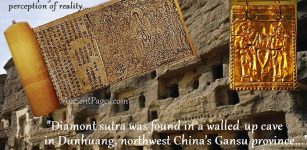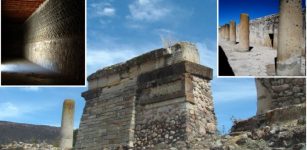Aztec Empire: ‘Tlatoani’ – The Ruler With The Ultimate Power In The Land
AncientPages.com - 'Tlatoani' (literally means 'speaker' or "king" in English), was an official to whom all household heads owed allegiance, respect, and tax obligations. 'Tlatoani' had an important role in the Aztec Empire.
The tlatoani’s position was fixed within a particular lineage, the particular choice varying from state to state. It was the highest position in the political hierarchy.
The Aztecs called their ruler the Huey Tlatoani, the highest political, military, and religious leader. This person spoke in both the divine and human realms. To perform this special role, the tlatoani was obliged to make proper human sacrifices to the divinities. It is commonly known from the ancient records that the Aztec Empire excelled at these tasks.
The city-states of the Aztec Empire each had their own Huey Tlatoani with the ultimate power.
He would be the high priest and military leader for his city-state. He would be considered their chief and commander. As the Tlatoani he would make every decision for his city-state from taxes to warfare.
He would always be a descendent of the royal family. Since the Tlatoani was allowed to have several wives his legacy would be easily maintained. After being established as the Tlatoani, he would be the Tlatoani of his region for life.
The Tlatoani was chosen by a council of elders, nobles, and priests. He would be selected from a pool of four candidates. At the death of each tlatoani, the Council met and elected a successor.
See also:
Fearsome Aztec Eagle Warriors And Jaguar Warriors Of Mesoamerica
It should be noted that it is very likely that these councils conflicts between different groups give to promote who best suited their interests, but there is no evidence that once the decision is someone objected or put into question the act of vested with the maximum range.
Montezuma II (c. 1466 – 29 June 1520) was the ninth tlatoani or ruler of Tenochtitlan, reigning from 1502 to 1520.
It is uncertain, whether he was killed by his countrymen or by the Spanish during the initial
stages of the Spanish conquest of Mexico, when Conquistador Hernán Cortés and his men fought to escape from the Aztec capital Tenochtitlan.
On May 31 1521, Cuauhtemoc, the last tlatoani, was captured. Tortured to reveal the whereabouts of the gold Cortés and his men craved, Cuauhtemoc was eventually hanged, but since the Mexican revolution against Spanish rule in 1810, his reputation as a national hero has grown.
AncientPages.com
More From Ancient Pages
-
 On This Day In History: One Of The Tallest Women In History – Died – On August 5, 1888
News | Aug 5, 2016
On This Day In History: One Of The Tallest Women In History – Died – On August 5, 1888
News | Aug 5, 2016 -
 Ancient Tomb Of Peru’s Moche Priestesses Unearthed
Archaeology | Jul 23, 2016
Ancient Tomb Of Peru’s Moche Priestesses Unearthed
Archaeology | Jul 23, 2016 -
 Ancient City Of Koh Ker Was Occupied Much Longer Than Previously Thought
Archaeology | Oct 12, 2018
Ancient City Of Koh Ker Was Occupied Much Longer Than Previously Thought
Archaeology | Oct 12, 2018 -
 On This Day In History: Moscow Armistice Signed Between Finland And Soviet Union – On Sep 19, 1944
News | Sep 19, 2016
On This Day In History: Moscow Armistice Signed Between Finland And Soviet Union – On Sep 19, 1944
News | Sep 19, 2016 -
 Mystery Of The Lost Underground City Of The Grand Canyon
Featured Stories | Nov 19, 2014
Mystery Of The Lost Underground City Of The Grand Canyon
Featured Stories | Nov 19, 2014 -
 Archaeologist Ludovic Slimak Wants To Rewrite The History Of Early Humans In Europe
Evolution | Jun 10, 2023
Archaeologist Ludovic Slimak Wants To Rewrite The History Of Early Humans In Europe
Evolution | Jun 10, 2023 -
 Sogdian Temple Of Jartepa II On Caravan Road Of The Silk Road
News | Sep 3, 2020
Sogdian Temple Of Jartepa II On Caravan Road Of The Silk Road
News | Sep 3, 2020 -
 Jurassic Sea Creature Unearthed In A Quarry Near Peterborough, UK
News | Dec 14, 2023
Jurassic Sea Creature Unearthed In A Quarry Near Peterborough, UK
News | Dec 14, 2023 -
 El Mirador: Ancient Pyramids Hidden In The Lost City Of The Maya
Featured Stories | Aug 1, 2018
El Mirador: Ancient Pyramids Hidden In The Lost City Of The Maya
Featured Stories | Aug 1, 2018 -
 Golden ‘Etruscan’ Orphic Book – Six Golden Pages Of The Oldest Book In History Of Mankind
Artifacts | Mar 27, 2020
Golden ‘Etruscan’ Orphic Book – Six Golden Pages Of The Oldest Book In History Of Mankind
Artifacts | Mar 27, 2020 -
 Drones Find Evidence Roman Siege Of Masada Lasted Much Shorter Than Previously Thought
Archaeology | Sep 6, 2024
Drones Find Evidence Roman Siege Of Masada Lasted Much Shorter Than Previously Thought
Archaeology | Sep 6, 2024 -
 Georgia Guidestones Damaged By An Explosive Device – By Whom And Why?
News | Jul 7, 2022
Georgia Guidestones Damaged By An Explosive Device – By Whom And Why?
News | Jul 7, 2022 -
 Mysterious Abaj Takalik Of Guatemala And Intriguing Relationship Between Olmec and Maya
Civilizations | Mar 16, 2020
Mysterious Abaj Takalik Of Guatemala And Intriguing Relationship Between Olmec and Maya
Civilizations | Mar 16, 2020 -
 3,000-year-old knight discovered at the Palidli necropolis
Civilizations | Aug 22, 2015
3,000-year-old knight discovered at the Palidli necropolis
Civilizations | Aug 22, 2015 -
 Sed Festival – Ancient Egyptian Ritual Tested Pharaohs
Ancient History Facts | Mar 28, 2018
Sed Festival – Ancient Egyptian Ritual Tested Pharaohs
Ancient History Facts | Mar 28, 2018 -
 2,000-year-Old Uluburun Shipwreck Reveal Complex Trade Network
Archaeology | Nov 30, 2022
2,000-year-Old Uluburun Shipwreck Reveal Complex Trade Network
Archaeology | Nov 30, 2022 -
 Why Were Wampum Belts Important To Native Americans?
Featured Stories | May 10, 2018
Why Were Wampum Belts Important To Native Americans?
Featured Stories | May 10, 2018 -
 Zapotecs’ Magnificent City Of Mitla Was Destroyed By A Seismic Landslide
Archaeology | Aug 23, 2024
Zapotecs’ Magnificent City Of Mitla Was Destroyed By A Seismic Landslide
Archaeology | Aug 23, 2024 -
 On This Day In History: Pueblo Indians Capture Santa Fe From The Spanish – On August 21, 1680
News | Aug 21, 2016
On This Day In History: Pueblo Indians Capture Santa Fe From The Spanish – On August 21, 1680
News | Aug 21, 2016 -
 Mystery Of Europe’s Bog Body Phenomenon Solved By Scientists
Archaeology | Jan 12, 2023
Mystery Of Europe’s Bog Body Phenomenon Solved By Scientists
Archaeology | Jan 12, 2023


